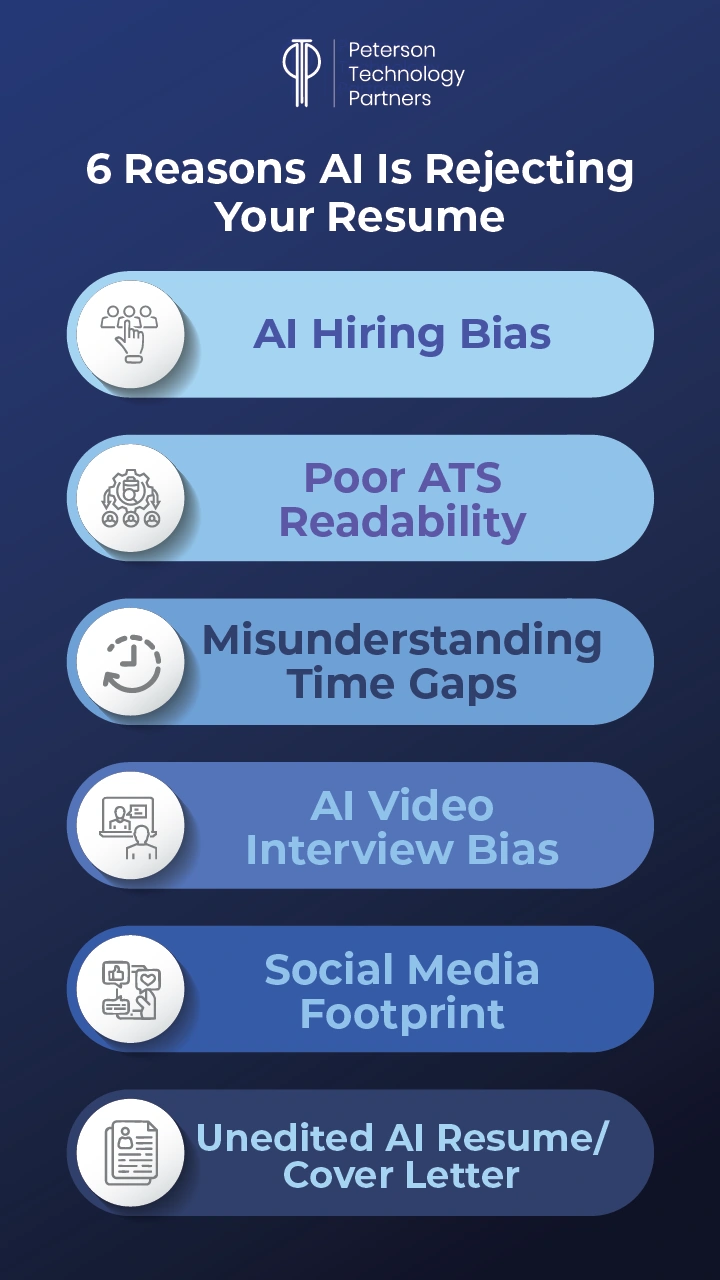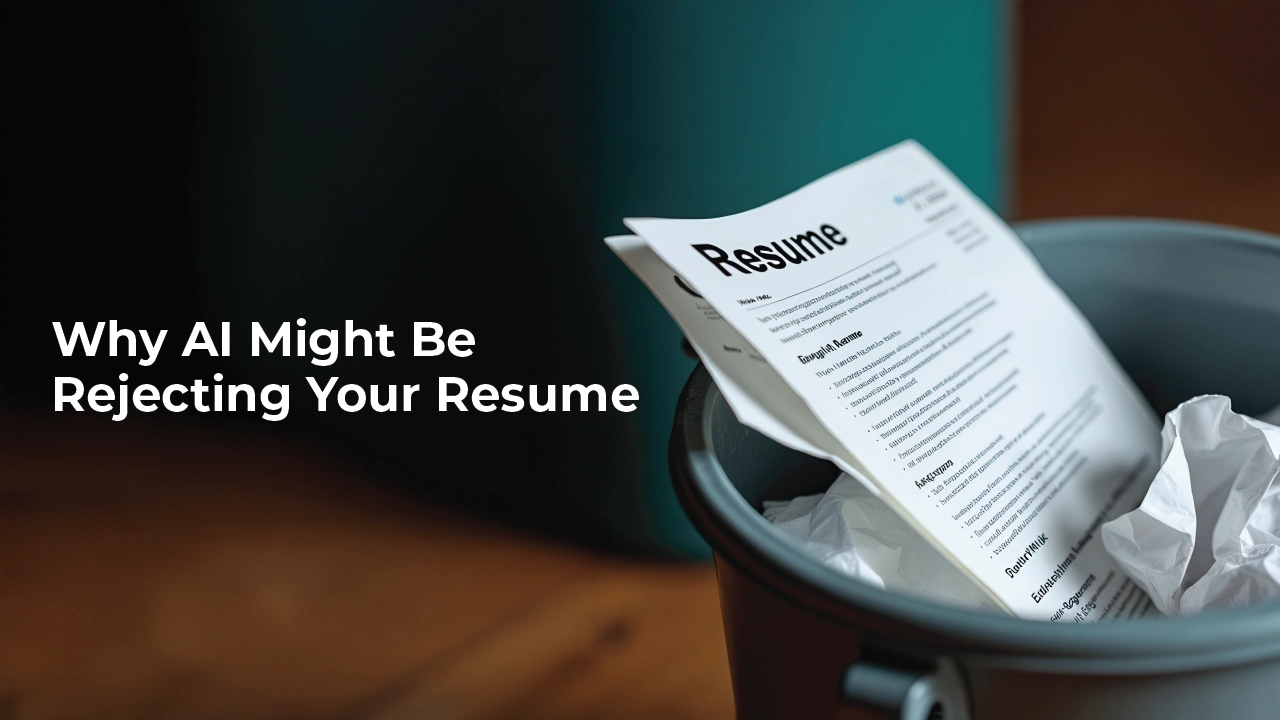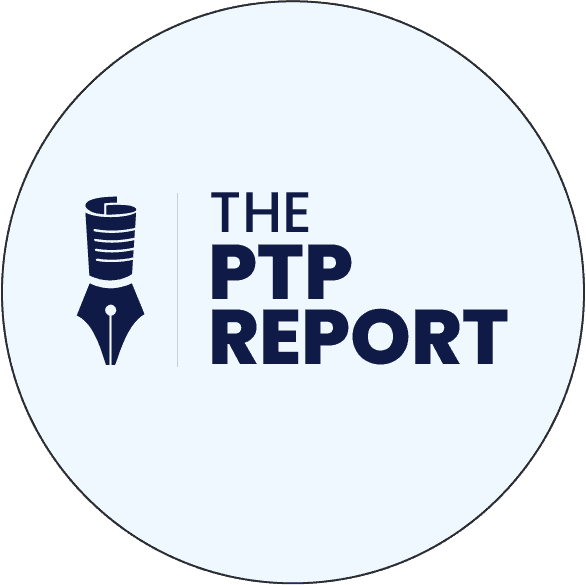In a time when AI resume screening is both the norm and still relatively new, it’s hard to know whether to cater your resume to:
- A very busy recruiter or hiring manager
- An AI-powered ATS
- The final, most influential human reader
And there is no perfect answer. AI growing pains are still prevalent far beyond talent acquisition, and an equilibrium hasn’t been fully established.
But, as a tech recruiting company and early adopters of AI, we do know some things about AI hiring, like why resumes get rejected by AI and how to write a resume for AI bots. And we want to share them with you, so keep reading.
Here is our list of reasons why AI might be rejecting your resume.

1. AI Can Misunderstand Resume Time Gaps
You may have a good explanation for a gap in your resume—and maybe you even communicate it effectively in your cover letter and are prepared to do so again in your interview—but it doesn’t matter if AI rejects you right away.
You can work around this, however, by making sure each month is accounted for by providing a brief explanation of what you were doing (and learning) during that period.
Try to format it like you would work experience, listing the time range the same way and including a couple bullets about any relevant experience or coursework you gained in that time, even if you weren’t employed.
2. AI Can Perpetuate Hiring Bias
It’s no secret that AI is trained on biased data. We live in a biased world, after all, so this is inevitable. And while forward-thinking employers are aware of this and make efforts to counteract bias in their AI models, you can still take measures to keep AI bias from working against you.
One way to counteract this is by avoiding gendered language; for example, state that you were involved in “athletics” in college rather than “softball”). Some opt to exclude dates for their education, which can give away a candidate’s age.
When in doubt, try to reflect the language used in the job description as much as possible without overstuffing your resume with keywords, because even though AI might like keywords, the eventual human viewing your resume won’t be as impressed if it reads unnaturally.
[Read this PTP Report for a breakdown of AI in the hiring process today.]
3. AI Can Be Biased in Video Interviews
AI interviews are a great way for hiring teams to save time and resources during the hiring process. But the way these interviews are assessed can also perpetuate bias.
One major example is how it processes body language. Many of these models are trained to dock interviewees who fidget or don’t make consistent eye contact because many people see these as signs that someone isn’t paying attention or doesn’t care. These can also be common behaviors of neurodivergent individuals, who often focus better when they can look and move around freely.
If possible, try picking a general spot to look at just past your camera when answering questions. And if you feel the need to fidget, you can try to do so by using a fidget toy out of frame.
4. AI Can Scan Your Social Media Footprint
There’s an increasing number of digital platforms leveraging AI to scan a candidate’s social media footprint, helping employers instantly gain a broader picture of the candidate as a whole person.
And today, there is a whole additional cultural and political context regarding social media. The Trump Administration recently announced a new policy requiring embassies and consulates to scan the social media of student visa applicants for “hostile attitudes towards [American] citizens, culture, government, institutions, or founding principles.” We have yet to see the direct impact of these policies on US job-seekers, but it’s safe to say we’re likely to see such developments reflected in the workforce soon.
Some experts say keeping your LinkedIn tight and clean while scrubbing your personal social media is not the answer, as it could come off as secretive, especially in a climate where employers are also worried about fake candidates.
The best way currently to give yourself an advantage is to stay in tune with news like this. (We like to keep our PTP Report readers in the know, so be sure to subscribe for the latest insights straight to your inbox!)
5. Your Resume Is Hard for AI to Read
This is one you’ve probably heard before, but it’s critical to use an AI-friendly resume format. Here are some quick tips that make a difference:
- Save your resume as a .docx file as opposed to .pdf
- Avoid headers, text boxes, and graphics, which tend to confuse ATS
- Label each section clearly (i.e., Professional Summary, Work Experience, Skills and Certifications, etc.)
- Include links to any portfolios or personal projects as opposed to displaying them directly in the resume
- Use a font that’s easy for ATS and humans to read, like Arial, Calibri, or Times New Roman in 10–12–point font
[For more tech resume tips for job seekers, read this PTP Report.]
6. You Did Not Edit Your AI-Generated Resume/Cover Letter
We live in a confusing time when some employers encourage AI use in the hiring process (see Meta, who recently announced they are allowing coding applicants to openly use AI in coding interviews), while others still consider it cheating.
At PTP, we encourage tech job candidates to use AI for what it’s good at: practicing for interviews, integrating resume keywords for ATS, or simply getting something down on the page. We also encourage candidates to understand when they need to step in as humans if they want to stand out from the hundreds of other applicants using AI. (You can read all about this in our CEO’s recent newsletter.)
To cover your bases, it’s wise to learn how to pass an AI resume check. Luckily, once you have personalized your AI output, you can simply use an AI resume checker to ensure you won’t get eliminated by anti-AI employers.
Conclusion
These tips do more than teach you how to beat ATS; they will help you improve your chances altogether. By harnessing the best of GenAI’s abilities and personalizing the output, you can set yourself apart from the competition and reach new heights in your career.
And remember to submit your upgraded tech resume to PTP to join our premiere IT talent pipeline!
FAQs
Do recruiters care if I used AI to generate my job application materials?
Recruiters want to find the best person for the job, not just in terms of skills and experience but also culture and personality. So, if applicants use AI to apply, that is okay, as long as they have clearly gone out of their way to personalize their materials. Not only does this set them apart from the competition, but it shows that, even if they used AI, they still put in the effort to tailor their application to the position.
How can I stand out as a candidate if everyone is using AI to craft the perfect resume and cover letter?
Make your application stand out by ensuring your cover letter and other written communication with the hiring team showcases your personality. You can use AI to help, but never send an AI-generated resume, cover letter, or message without taking the time to revise it to make it more personal and natural—whether that means finding something to connect over or just asking yourself, Would I actually say this if I was face-to-face with this person?
How do you know if AI rejected your resume?
If you received a rejection within one or two days of applying, it was probably rejected by AI. However, there is currently no concrete way to know for sure. If you haven’t received a response about your application within a week or so, you can reach out directly to the recruiter or hiring manager to follow up, re-attaching your resume in the message. Getting in touch with a human could give you an advantage, even if AI already rejected your resume.





